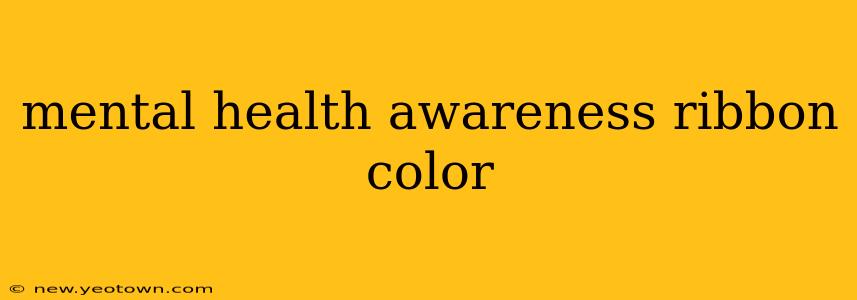The simple, yet powerful, image of a ribbon has become a globally recognized symbol of awareness for various causes. For mental health, the color chosen carries significant weight, representing hope, resilience, and the ongoing fight against stigma. But what is the mental health awareness ribbon color, and why was it chosen? Let's unravel the story behind this vital symbol.
While there isn't one single, universally adopted color for all mental health awareness, green has emerged as the most commonly associated color. This isn't a decision made by a single organization; rather, it's an organic evolution, solidified through widespread adoption across various mental health charities and initiatives.
The green ribbon's significance is multi-faceted. Green often symbolizes growth, healing, and new beginnings—all crucial aspects of the mental health journey. It's a calming and refreshing color, representing the peace and serenity many strive for in their mental wellness. Think of lush green landscapes, often associated with tranquility and rejuvenation—this is the essence the color conveys in the context of mental health.
Why is green the most commonly used color for mental health awareness ribbons?
This isn't a formally designated color by a single governing body. The prevalence of green likely stems from its inherent associations with nature, calmness, and growth. The color subtly communicates the ongoing journey towards healing and well-being, subtly different from the more urgent or somber colors used for other causes. Over time, its consistent use across many organizations cemented its association with mental health awareness.
What other colors are associated with mental health awareness?
While green is dominant, other colors often represent specific mental health conditions or aspects of mental well-being. For example, you might see:
- Yellow: Often used to represent suicide prevention awareness.
- Purple: Sometimes used to represent eating disorders awareness.
- Orange: May represent anxiety awareness in some campaigns.
It's crucial to remember that the specific color used can vary depending on the organization and the specific focus of their campaign. The primary goal is to raise awareness and reduce stigma, and the color is merely a visual tool to aid in that effort.
Are there specific ribbons for different mental health conditions?
Not always. While some organizations may use specific colors for particular conditions, a general green ribbon often serves as a symbol of overall mental health awareness and support for individuals facing a broad range of challenges. This helps promote understanding and inclusivity, fostering a sense of community for all those affected.
What is the purpose of using a ribbon for mental health awareness?
The ribbon's purpose is multi-pronged:
- Raising awareness: The visible symbol encourages conversations and prompts people to learn more about mental health issues.
- Reducing stigma: Wearing or displaying the ribbon demonstrates solidarity and helps to normalize discussions surrounding mental health.
- Promoting support: It signifies support for individuals and families affected by mental illness.
- Encouraging help-seeking: The ribbon can act as a subtle reminder that help is available and encourage those struggling to reach out for support.
The mental health awareness ribbon, predominantly green, is more than just a piece of fabric or a printed image. It's a potent symbol of hope, resilience, and the ongoing collective effort to destigmatize mental illness and promote well-being. Its simple design carries a powerful message of support and understanding, reminding us all that mental health matters.

